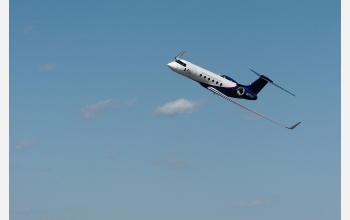News Release 05-033
Advanced Research Aircraft to Arrive at Colorado Facility this Week
New NSF plane will go higher and farther on environment studies

HIAPER departing Savannah Airport on a certification flight in March, 2005.
March 9, 2005
This material is available primarily for archival purposes. Telephone numbers or other contact information may be out of date; please see current contact information at media contacts.
A new aircraft with exceptional research capabilities is scheduled to arrive at the National Center for Atmospheric Research (NCAR) in Colo., this Friday. Known as HIAPER (High-performance Instrumented Airborne Platform for Environmental Research), the $81.5 million aircraft will serve the environmental research needs of the National Science Foundation, (NSF), NCAR's primary sponsor and owner of the aircraft, for the next several decades
HIAPER, which is scheduled to begin research missions later in 2005, will provide scientists with insights into the atmosphere and Earth’s natural systems. A modified Gulfstream V jet, the aircraft can fly at an altitude of 51,000 feet and has a range of 7,000 miles. It can carry 5,600 pounds of sensing equipment, putting it at the forefront of scientific discovery.
“HIAPER's range, duration, and high-altitude capability, combined with a significant scientific payload, make it the most advanced aircraft research platform in the United States,” says James Huning, HIAPER program director at NSF.
“The arrival of HIAPER ushers in a new era of environmental research opportunity for NCAR and for the entire geosciences community,” says Krista Laursen, HIAPER project director at NCAR. “HIAPER will make it possible for scientists to study meteorological processes and environmental phenomena that are continental or nearly global in scale.”
HIAPER will collect data from the tops of storms and lower edge of the stratosphere, altitudes out of reach of most research aircraft. The craft’s range will enable scientists to survey remote ocean regions in a single flight to learn more about interactions between the oceans and atmosphere. Future missions include:
- Following pollution plumes across continents and oceans to determine where pollutants originate and how they affect the atmosphere
- Studying hurricanes as they emerge
- Mapping Earth’s surface with an array of remote sensors
- Flying through high-forming cirrus clouds to create vertical portraits of their physical and chemical properties
The entire environmental sciences community will have access to the aircraft, says Huning. Researchers will begin taking HIAPER on local science missions based out of Jefferson County Airport in Colo. in the fall. These early missions will allow pilots and technicians to familiarize themselves with the plane. The flights will also give scientists an opportunity to test and showcase the plane’s capabilities and perform some initial research.
"The best part of HIAPER is the ‘H,’ which stands for high-performance," says Jennifer Francis, an atmospheric scientist at Rutgers University in New Jersey. "A research platform like HIAPER makes this an exciting time to be an atmospheric scientist."
In addition to NCAR, Gulfstream Aerospace Corporation, Lockheed Martin, and the Garrett Aviation Consulting Group have been involved in the development of HIAPER.
-NSF-
Media Contacts
Cheryl L. Dybas, NSF, (703) 292-7734, email: cdybas@nsf.gov
Anatta , UCAR, 303-497-8604, email: anatta@ucar.edu
Related Websites
On the Web: For more information about HIAPER: http://www.hiaper.ucar.edu
The U.S. National Science Foundation propels the nation forward by advancing fundamental research in all fields of science and engineering. NSF supports research and people by providing facilities, instruments and funding to support their ingenuity and sustain the U.S. as a global leader in research and innovation. With a fiscal year 2023 budget of $9.5 billion, NSF funds reach all 50 states through grants to nearly 2,000 colleges, universities and institutions. Each year, NSF receives more than 40,000 competitive proposals and makes about 11,000 new awards. Those awards include support for cooperative research with industry, Arctic and Antarctic research and operations, and U.S. participation in international scientific efforts.
Connect with us online
NSF website: nsf.gov
NSF News: nsf.gov/news
For News Media: nsf.gov/news/newsroom
Statistics: nsf.gov/statistics/
Awards database: nsf.gov/awardsearch/
Follow us on social
Twitter: twitter.com/NSF
Facebook: facebook.com/US.NSF
Instagram: instagram.com/nsfgov
